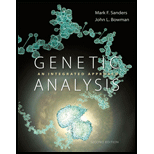
Concept explainers
Identify two general ways chemical mutagens can alter DNA. Give examples of these two mechanisms.
To review:
Analyze how chemical mutagens can alter DNA. Give examples of these two mechanisms of chemical mutation.
Introduction:
Mutation can be defined as a heritable change in the DNA sequence. This change in the DNA sequences either leads to evolutionary change in the DNA, or it changes the gene sequence which disturbs its desirable function and affects the fitness of the organism. Mutation occurs very rarely and randomly. The physical or chemical substance which causes the mutation in the DNA is called the mutagen. Examples of the physical mutagens are radioactive substances, X-rays, and ultraviolet rays, and those of chemical mutagens are Nitrous acid, Acridine, proflavin and Base analogues.
Explanation of Solution
Chemical mutagen is the compound which causes mutation in DNA as it alters the sequence of the DNA. Types of chemical mutation:
1) Base analogue mutation
2) Intercalating agents
3) Deamination
4) Alkylating agents
1) Base analogue mutation: A base analogue is the chemical compound that mimics nitrogen bases and gets incorporated in place of normal base in the DNA. As these compounds are not the true base pair, they possess some different characters of the pairing to the complementary base pair. This wrong incorporation of the nitrogen base in the DNA leads to mutation.
A known example of the base analogue is
2) Intercalating agents: A chemical that loads itself in between the stacked bases of the DNA is called the intercalating agent. This intercalation of chemicals in DNA results in either insertion or deletion of the bases; this results in frameshift mutation of the DNA.
The examples of intercalating agents are Acridine orange, proflavin, and acriflavin. These dyes have a three ringed structure which resembles with purine- pyrimidine base pairing. Purine has a double ring structure while the pyrimidine has a single ring structure; when they pair, they form a three ring structure. When the dyes intercalate into the DNA, it results in the deletion or insertion of the of the DNA replication, therefore frameshift mutation.
A chemical mutagen causes changes in the sequence of the DNA, it is called chemical mutation.
Want to see more full solutions like this?
Chapter 12 Solutions
Genetic Analysis: An Integrated Approach (2nd Edition)
- Contrast and compare the mutagenic effects of deaminating agents, alkylating agents, and base analogsarrow_forwardList and describe three important processes are affected by DNA supercoiling.arrow_forwardExplain how a mutagen can interfere with DNA replication to cause a mutation. Give two examples.arrow_forward
 BiochemistryBiochemistryISBN:9781305577206Author:Reginald H. Garrett, Charles M. GrishamPublisher:Cengage Learning
BiochemistryBiochemistryISBN:9781305577206Author:Reginald H. Garrett, Charles M. GrishamPublisher:Cengage Learning
